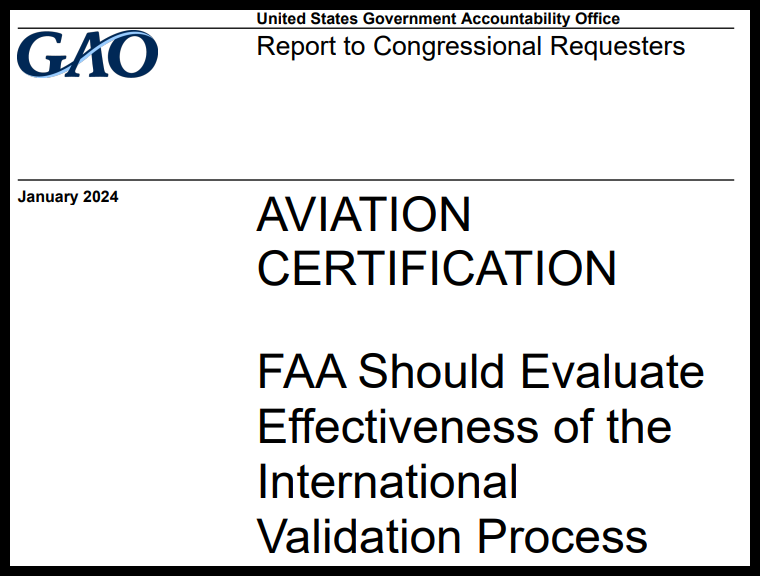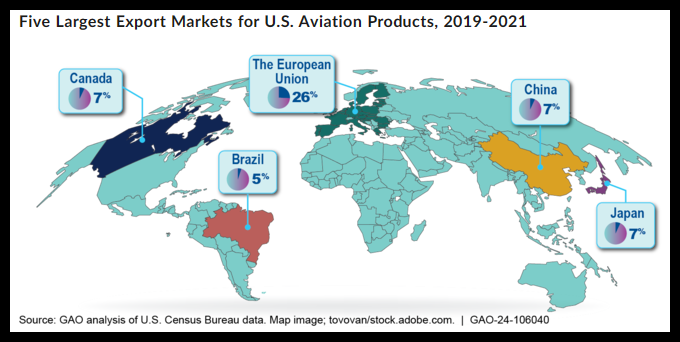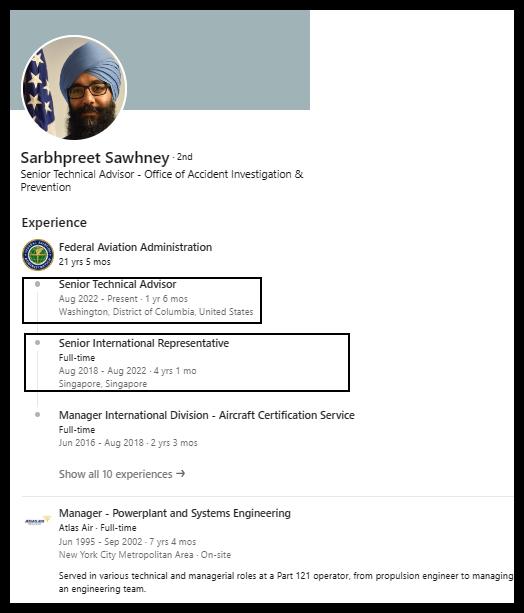Foreign TC Validation needs FAA people, not GAO’s process

In response to a Congressional request the Government Accountability Office (GAO) devoted 21 months (May 2022 to January 2024) to study the Effectiveness of the FAA’s International

Validation Process (“GAO study”). They had extensive Interviews with FAA staff, OEMs, trade associations and 4 Foreign Civil Aviation Certification Authorities [CAAs] (Brazil’s Agência Nacional de Aviação Civil (ANAC), Transport Canada, and the Japan Civil Aviation Bureau). Curiously, the European Union Aviation Safety Agency (EASA), the Civil Aviation Administration of China, and the United Kingdom Civil Aviation Authority declined to participate in these discussions; particularly since these CAAs are involved with over 33% of foreign validations.

Their recommendations focused on process and quantification:

All good, and completely supported by their 37 pages of analysis, but the most telling finding of the GAO is–
“DECREASED TRUST in FAA’s certification process. Most stakeholders said that the two accidents involving the Boeing 737 MAX 8 airplane in 2018 and 2019 decreased validating CAAs’ trust in certifications performed by FAA and, in turn, increased scrutiny and information requests from CAAs when validating FAA-certificated products. These stakeholders said that the decrease in trust has been especially evident in areas of aircraft design, such as how pilots interface with the aircraft’s controls and assumptions about how pilots will perform in abnormal situations. For example, a few stakeholders we spoke with said that they have received increased requests by CAAs for information in those areas, whereas PREVIOUSLY VALIDATING CAAS HAD GENERALLY ACCEPTED FAA’S CERTIFICATION FINDINGS. FAA officials said that they have also seen increased requests for data and testing from some validating CAAs in the wake of the 737 MAX 8 accidents. These officials said they work with their counterparts to resolve these information requests.” Study p.17
Establishing standards for the CAA’s replies will do little or nothing convincing its engineer that the FAA’s analysis deserves 100% credibility. REMEMBER: 60 countries, including close allies of the US, grounded the Max 8. Needless to say, the global impression of the FAA certification rigor has not improved since.
Process may help identify problems, but TECHNICALLY COMPETENT PEOPLE are required to REESTABLISH REPUTATION. Making sure that the FAA representatives know the issues and can talk expertly on complex engineering issues. The dialogues between the FAA and its peers are most telling; to create credibility the women and men supporting the US Type Certificate holder must have the level of understanding to respond quickly and accurately. Congress, who asked for this GAO assessment, should leave process to Administrator Whitaker, David Boulter, and Lirio Liu. The Administration and the Hill MUST focus on an appropriation that raises the number and level of FAA certification staff (the study also notes that the FAA domestic resources are overtaxed.)
Trust is not easily reestablished. Even prior to the Max 8 debacle, the FAA’s relationship with other CAAs was not great. At one time, offices were strategically located around the globe, positioned so that the representatives could contact and develop connections with their foreign peers. Geography was one element of this regulatory diplomacy. The professionals assigned to these high profile positions were often highly qualified to exchange information with the CAA staff—sharing useful insights, talking shop, and creating trust. CONSIDER: before and especially after Max 8, a senior CAA executive of Country A meets, for the first time (i.e., no prior conversations), someone “representing” the FAA (frequently a US embassy liaison with only a superficial knowledge of airworthiness, at best) to explain some serious airworthiness issue. NOT A WAY TO REINSTATE TRUST!!!
Assistant Administrator should be commended for his campaign to enhance his overseas offices; presence is clearly importance, but the ability to speak with authority is essential to make our CAA partners confident of the FAA’s competence.

the organization with the knowledge required to be imparted to other CAA’s exists within Lirio Liu’s team, Aircraft Certification and more precisely International Office, AIR-40. Here is their global reach:

Could there be only 2 offices and only Post Office boxes there? An example of an ideal person to enhance the FAA’s standing worked as the FAA representative in Singapore for 49 months. There must be other candidates to become ambassadors [small “a” intentional].

Overseas staffing is both expensive and involves bureaucratic State Department restrictions. If the Hill and the extensive US aerospace manufacturing community (AIA) want to improve the time that CAAs consume to validate the FAA’s TCs, then lobbying for the appropriations for the RIGHT PEOPLE to restore trust ESSENTIAL.

——————————————————————————————-
GAO: Validation Process Unpredictable Since Max Crashes
Stakeholders say foreign aviation authorities have less trust in FAA certification

The fallout of the Boeing Max crashes has included a decline in trust of the FAA from foreign civil aviation authorities, stakeholders told GAO.
By KERRY LYNCH • Editor, AIN monthly magazine
January 11, 2024
In the aftermath of the Boeing Max crashes, U.S. aircraft manufacturers have found the certification validation process has become UNPREDICTABLE. Civil aviation authorities (CAAs) are requesting more and a varying amount of data, as well as extending the duration of the review process, the Government Accountability Office (GAO) found.
As a result, the GAO is recommending that the U.S. FAA REVIEW ITS PROCESS for managing international validations to help build in more predictability. The GAO reviewed the processes out of concerns that, despite long-standing bilaterals, U.S. companies “continue to report experiencing difficulties in obtaining approvals of their products in other countries.”
Stakeholders interviewed cited A REDUCED TRUST these CAAs have in FAA’s certification following the Boeing 737 Max 8 accidents that occurred in 2018 and 2019. At the same time, FAA staffing and resource limitations have proved challenging in its ability to resolve disputes with other CAAs, the government watchdog added.
The FAA has begun to collect more detailed information surrounding its management of international validations. “However, FAA has not evaluated the effectiveness of the validations process as a whole,” the GAO said. It further noted that the FAA is in the early stages of developing an approach to assess the process, but has not yet identified specific steps or time frame for such an approach.
“Assessing the validations process could help FAA identify improvements that might lead to increased predictability in the process and improved accountability to bilateral agreements,” the GAO said.
Specifically, the GAO is recommending that FAA establish quantifiable goals for the validation process, provide performance metrics for achieving those goals, assess the results to determine necessary improvements, and establish a timeframe for this effort. The FAA agrees with the recommendations, the GAO added.